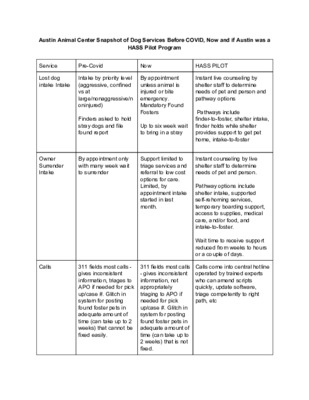Jefferson AAC Services Pre COVID — original pdf
Backup

Austin Animal Center Snapshot of Dog Services Before COVID, Now and if Austin was a HASS Pilot Program Service Pre-Covid Now HASS PILOT Lost dog intake Intake Intake by priority level (aggressive, confined vs at large/nonaggressive/n oninjured) Finders asked to hold stray dogs and file found report By appointment unless animal is injured or bite emergency. Mandatory Found Fosters Up to six week wait to bring in a stray Instant live counseling by shelter staff to determine needs of pet and person and pathway options Pathways include finder-to-foster, shelter intake, finder holds while shelter provides support to get pet home, intake-to-foster Owner Surrender Intake By appointment only with many week wait to surrender Support limited to triage services and referral to low cost options for care. Limited, by appointment intake started in last month. Instant counseling by live shelter staff to determine needs of pet and person. Pathway options include shelter intake, supported self-rehoming services, temporary boarding support, access to supplies, medical care, and/or food, and intake-to-foster. Wait time to receive support reduced from weeks to hours or a couple of days. Calls come into central hotline operated by trained experts who can amend scripts quickly, update software, triage competently to right path, etc Calls 311 fields most calls - gives inconsistent information, triages to APO if needed for pick up/case #. Glitch in system for posting found foster pets in adequate amount of time (can take up to 2 weeks) that cannot be fixed easily. 311 fields most calls - gives inconsistent information, not appropriately triaging to APO if needed for pick up/case #. Glitch in system for posting found foster pets in adequate amount of time (can take up to 2 weeks) that is not fixed. Sheltering Most of “normal intake” animals are not sheltered nor case managed. Most animals live at shelter until rto, adopted, transferred or euthanized. Foster placement efforts focus on medical animals and long stay animals Fewer than 3,000 pets to foster annually Centralized in shelter clinic Animals must be surrendered and permanently separated from owner to receive care Medical care for pets Minimal in shelter clinic Majority of animals who need sheltering are marketed to foster home before or at the time of intake. 50% or more pets go to foster homes annually (8-9,000) Case Manager follows animals sheltered in the community to ensure appropriate outcome Most animals can receive care without being ‘surrendered’ by their owner. Community partnerships ensure pet owners have a variety of accessible care options. Telehealth services to evaluate animal needs prior to intake.